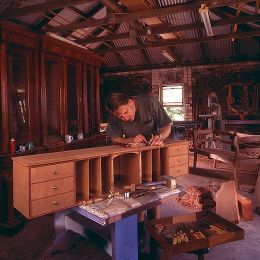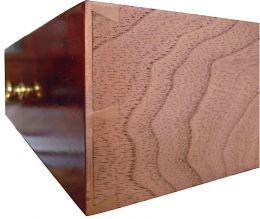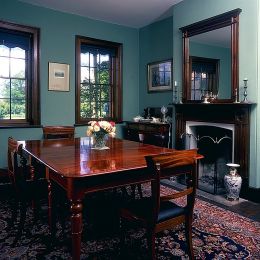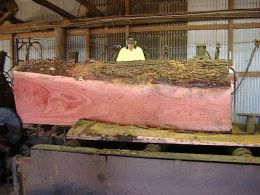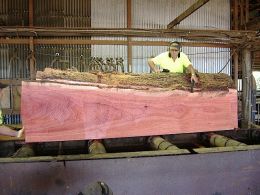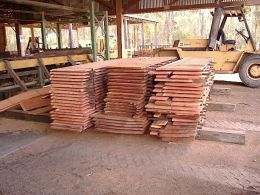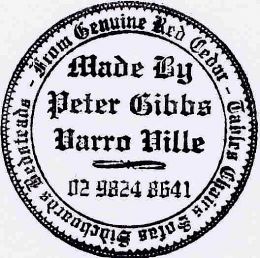PETER GIBBS, BESPOKE FURNITURE MAKER
Precis
Peter Gibbs (b.1953) has been making fine Australian Red Cedar Furniture from the 1788-1850 period on a commission basis for the last thirty years.
The 1788-1850 period, reflecting the Georgian, Regency and William IV styles of England, is regarded as the Golden Age of Australian Furniture and examples from it are amongst the rarest furniture antiquities in the world. As many of the original pieces are lost or are in private ownership, national collections and house museums, there are not enough original pieces left to furnish the remaining historic houses or for those who want standalone art pieces.
Australian Red Cedar, (Toona Ciliata), particularly from NSW, is one of the great cabinet timbers and more than any other tree is associated with Australian furniture history. It was harvested to near extinction and today is a rare and valuable species. It is protected on Crown Land but Peter has been able to source this timber in sufficient quantities from private properties.
Peter buys, mills and seasons his own trees before fashioning and hand polishing his pieces. This exclusive process, using only Australian cedar and where one man does everything, was the practice of cabinet-making in the19th century. Peter has been described affectionately as a "dinosaur", and may well be the last traditional hand-maker of Cedar furniture in Australia who works within these two hundred year old parameters.
Early Influences
Peter Gibbs originally trained as a classical musician, educated in cello, composition and conducting at the State Conservatorium of Music.
However from the 1970s Peter’s love of early Australian cedar furniture was already turning into a serious hobby of collecting, conserving and repairing fine pieces. Peter attributes his dual affections to a tradition begun with his grandfather with whom he spent vast amounts of time as a child. Cyril Gibbs, a violinist in Newcastle NSW, made and repaired violins and furniture giving the young Peter an unconscious apprenticeship in cabinet-making as well as music.
Peter was fortunate to have been born in Newcastle (established 1804), the gateway to the Hunter Valley in NSW where the best cedar had always been found and where there was a long tradition of fine joinery, furniture making and shipbuilding. These traditions continued into Peter’s early adulthood. From a factory attached to a shop on Beaumont Street, the main street of the busy suburb of Hamilton, a local institution continued to operate into the 1990s. Fred Barrie (1903-1999) was the last remaining traditional maker of Cedar furniture still using 19th century processes and designs from timber he had cut, milled and seasoned himself. In 1944 Fred cut a huge Cedar tree near Gloucester. He paid £900 for it, which was the price of a house in those days. He made furniture from that tree for over four decades and was still working in his nineties.Peter still has furniture his mother commissioned from Fred and remembers this factory with great affection. Dark, Dickensian, with a foot of ancient Cedar dust on the floor, templates hanging from every inch of available wall space and huge, old woodwork machines driven by overhead belts, it was the stuff of dreams. In the last remaining corner of free space, clad in a leather apron, was the diminutive Fred, struggling to dig himself out of the shavings to converse.
Fred Barrie made pieces in the late Victorian style that he grew up with: the strange hybrid of French Louis 15th and 16thand English Chippendale revival that was all the rage at the end of the 19th century. However it was the process that fascinated Peter rather than the style of furniture, as Peter’s interests were for that made a hundred years before Fred was born.The key to the process was the link between maker and client that had already begun to disappear with the establishment of large retail stores after the Great Exhibition of 1851. As a bespoke maker, Fred Barrie had somehow managed to keep one foot in a former age.
Early Career
While teaching music as his grandfather had done, Peter began restoring early colonial Cedar furniture. In time people started bringing him their own pieces - bought at auction or handed down through the family. The process of restoration and conservation allowed Peter to uncover early methods of construction. Peter began making pieces to supplement his own collection, and was finally commissioned by clients to make museum copies of family pieces or rarities from magazines and books that could not otherwise be bought due to the dwindling and limited supply of original pieces.
Peter left teaching to concentrate on the burgeoning business. Some clients, who were building expensive and substantial houses in the colonial style, began to commission whole rooms such as dining rooms, libraries, drawing rooms and bed rooms, as they wanted one-off pieces which could be passed down through generations of one family with the house, exactly mirroring the colonial process of the 19th century. Some of these were town houses, others, in rural locations.
Sometimes he was asked to fashion classical pieces for houses built in a contemporary or avant-garde style where the client wanted to mix modern furniture with the occasional traditional piece to achieve a powerful contrast of a standalone work of art in an elegant location.
Mid-Career
Employing French Polishers and apprentices soon found Peter spending too much time in the office and not doing what he loved most. Peter decided to return his business to the traditional approach of 19thCentury provincial cabinet makers, working mostly alone on high end art pieces for clients with whom he could develop a close and satisfying working relationship. Although not the main focus of his business, Peter still restores and conserves original pieces for clients as an all-round service and to continue his education with the early masters of his profession.
Today
Until 2010, Peter had spent most of his life in the Hunter Valley, close to the supply of Cedar. There he became well known and built furniture not only for Australian clients but also for those overseas. His pieces found their way to the United States, Hong Kong and New Zealand. However in 2010, working at the height of his career, he decided to relocate closer to Sydney, building a new workshop in the historic landscape setting of the Scenic Hills between Campbelltown and Camden, and within easy reach of Sydney, the Southern Highlands and the Blue Mountains.
Peter uses no other primary timber but Australian Cedar, which, under his personal supervision, is sourced, felled, milled and air-dried. He guarantees that this is AAA grade cabinet cedar from NSW and not the inferior, less dense and lighter coloured timber from higher latitudes in South East Asia where Cedar is now also known to grow. All the highly prized early colonial pieces came from NSW Cedar as it had all the decorative grain structures to be found in the Mahogany used in the English models. This is an important feature of early Australian furniture typified by restrained ornament where the decoration is in the wood itself. Peter has tried to retain this essence of simple forms from flamboyant wood. The accompanying images show this timber being milled into wide boards.
Peter refuses to make fakes or pass off new for old or engage in ‘reproduction’, which he considers a ‘dirty’ word. Instead Peter sees himself as the inheritor and exponent of a cabinetmaking tradition which he wants to preserve. All of his pieces carry his personalised stamp and date.
Peter finishes all his pieces in traditional shellac based, hand-rubbed French Polish which has a high shine at the outset. This mellows, cures and patinates over hundreds of years like the originals. He recommends this rather than trying to fake age. If it is part of the brief, he can modify this finish so that these pieces can blend with antique collections. However, with standalone pieces, he recommends using the time-honoured process and appreciating the beauty of them as they appeared when new. All French Polishers know that hardness is bound up with the shine and interfering with this process may affect the longevity of the finish.
The use of rare and special wood, observation of original proportions and construction, and as much hand work as possible in execution and finish, have led Peter on a journey of remarkable rediscovery.
The result is furniture which has all the contradictions of the originals…elegant yet monumental…decorative yet practical…restrained yet flamboyant.
